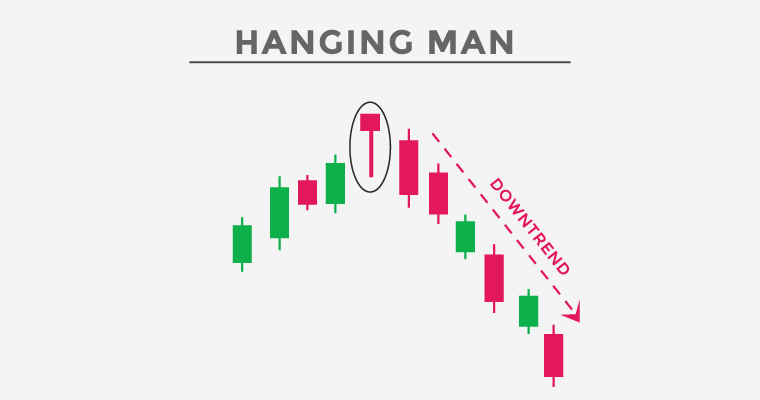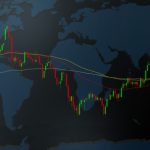What Does Hanging Man Candlestick Indicate in Trading?

Hanging man candlestick pattern in financial analysis helps traders determine the magnitude and strength of price movements. This pattern indicates a bearish reversal in which markets open near the high price, sustain the momentum and close near their low. When these datasets are plotted on a candlestick chart, the formation appears like a man hanging in an upside manner.
This article is a complete guide to hanging man candlestick pattern, why it forms, what it indicates, its features, advantages and limitations. Read on!
What is Hanging Man Candlestick Pattern?
As the name suggests, this pattern looks similar to a man hanging in an upside manner. The hanging man pattern can occur at both the resistance and support levels. However, as per market analysts, these are quite common at support levels after a reduction in the price level.
The Colour of the candlestick in this pattern depends on whether the closing price was higher or lower than the opening price. If the colour of the candlestick is red or black, it means that the closing price was lower than the opening one. On the other hand, if the closing price is higher than the opening price, it will exhibit a green or white candlestick.
When markets face an uptrend, these candlesticks will appear near the low point. As trading progresses through the day, prices will rise and close at a significantly high level.
Now that you are aware of the meaning of the hanging man pattern, let’s shift our focus to its other aspects.
What Leads to the Formation of the Hanging Man Pattern?
These patterns get formed only when two criteria are met:
- The candlestick will have a small real body with long upper shadows.
- The underlying asset is exhibiting an uptrend or rise in its prices.
If this pattern emerges during an uptrend, it will indicate a loss of strength among buyers. It will mean a bearish reversal and heavy selling pressure. Buyers may push these prices near their opening level with a forecast of a peak.
The upcoming peak, as well as eventual downtrends in that particular stock, will compel traders to indulge in selling and exit the trade.
What Are the Features of Hanging Man Candlestick Pattern?
Here are some features of this pattern:
1. Upward trend:
This pattern generally forms at the top of a prevailing uptrend in the price of a security.
2. Upper shadow:
A small upper shadow in length symbolises efforts made by buyers to maintain the current trend before the fall in the price started gaining traction.
3. Opening level:
This pattern can represent either a green or red candlestick. A green candle is representative of bullish conditions, and a red indicates bearish sentiments.
4. Longer lower shadows:
There is a long lower shadow in this pattern. This means a strong selling sentiment in the market before bulls try to capture the market, thereby driving the closing price nearer to its opening counterpart.
5. Closing level:
There will be a bearish trend if the closing price is lower than the opening value.
Also Read
How to Identify Hanging Man Candlestick?
It is a trend reversal pattern that forms with a long wick on the downside. You can easily spot this pattern visually because of its unique structure, i.e., long body and small wick. Usually, it appears at the top of a prevailing uptrend. It contains both bullish as well as bearish sides.
Moreover, the shadow of these candlesticks must be relatively smaller than the real body. You can visually identify these patterns by looking at all these structural formations.
How to Trade Using Hanging Man Pattern?
This candlestick pattern is quite similar to the Doji one, with the exception that it has a real body. There are two varieties of candlestick patterns – one is bullish, and the other is bearish. The bullish patterns depict a general sense of indecision among traders.
By looking at bullish patterns and using them with other technical analyses like price-breaking points, resistance, etc., you can determine when to buy the concerned stocks. On the other hand, bearish hanging patterns will be useful to determine the selling point of the respective stocks.
It is imperative that you carry out any trade based on confirmed patterns only. Furthermore, you should be ready to stop losses in case forecasting doesn’t go as per the planning.
How Does the Hanging Man Pattern Correlate with Trend Reversal?
Trend reversal in a market will occur when a more powerful opposing force enters the market and seeks to change its direction. The most prominent signal of a trend reversal is turbulence or volatility at high or low price points.
The hanging man pattern analyses the market-related activity of both buyers and sellers before determining the eventual price direction. It indicates the dominance of bears or sellers after an uptrend or upswing. Therefore, you can use this to get signals of both with-the-tide and against-the-tide trading.
Example of a Hanging Man Candlestick Pattern
Let’s say that the stock price of Company ABC has opened at Rs.152. As trading goes on, it experiences heavy demand from many buyers. This shoots up the price of the stock, which begins to trade at Rs.175. However, as the end of the trading session gets nearer, the stock loses momentum.
It closes near its opening value at Rs.157. This indicates that bulls lost momentum, and there was a change in trend with bears taking control. This is depicted with the formation of a hanging man pattern in the candlestick charts.
Advantages of Hanging Man Candlestick Pattern
Here are some advantages of hanging man candlestick patterns:
- It gives a firm signal about an impending reversal in market trends.
- This pattern is quite easy to understand. Therefore, even new and budding traders can use them for trading strategies.
- This acts as a selling signal for traders. Whenever they see this pattern forming, they can sell and exit the trade to generate profit.
Disadvantages of Hanging Man Candlestick Pattern
Here are some limitations of this pattern:
- It may give out fake signals, which can lead to wrong trading.
- A hanging man candlestick is not a reliable indicator for giving out an entry signal.
Difference Between Hanging Man Candlestick and Hammer Candlestick
Hanging Man Candlestick and Hammer Candlestick patterns indicate a change in the direction of prices. The only major difference between them lies in the style of the trend which they form. If this pattern appears at the end of a prevailing uptrend or bullish market conditions, it is called hanging man candlestick.
On the other hand, if this pattern occurs at the end of a continuing downtrend, it is referred to as a hammer candlestick pattern.
Final Word
Hanging man candlestick is an important technical trading indicator that traders use to identify trend reversal in a certain stock. It indicates a rise in the selling interest among investors, which traders can use to make their investment decisions. However, one should also look out for confirmatory signals from other tools and charts before taking a position.
FAQs
Ans: Support and resistance levels are ranges between which the price of a stock moves. These are the boundaries within which the price of a stock hovers, and it usually doesn’t cross the limits. Even if it crosses the ranges, it is considered a temporary phenomenon.
Ans: The hanging man candlestick pattern can form in all markets. However, they are a more common phenomenon in the Forex markets due to their relation to a stock’s price volume and volume depth.
Ans: It is a bearish pattern because, after the emergence of this pattern, sellers gain a firm hand over their respective stock. The price of the concerned security witnesses a continuous rise preceding this pattern. It also depicts a lost momentum of bullish sentiments.
Ans: This pattern is also a trend reversal pattern, just like the hanging man candlestick. It forms when the prevailing market conditions are bearish or downside.
Want to put your savings into action and kick-start your investment journey 💸 But don’t have time to do research? Invest now with Navi Nifty 50 Index Fund, sit back, and earn from the top 50 companies.
Disclaimer: Mutual Fund investments are subject to market risks, read all scheme-related documents carefully.
This article has been prepared on the basis of internal data, publicly available information and other sources believed to be reliable. The information contained in this article is for general purposes only and not a complete disclosure of every material fact. It should not be construed as investment advice to any party. The article does not warrant the completeness or accuracy of the information and disclaims all liabilities, losses and damages arising out of the use of this information. Readers shall be fully liable/responsible for any decision taken on the basis of this article.

Customer’s Feedback
No comments found.10 Best Demat Accounts in India for Beginners in 2023
Creation of Demat accounts revolutionised the way trades were conducted at the stock exchanges. It... Read More »10 Best SIP Plans for 1000 Per Month in India 2023
Systematic Investment Plan (SIP) is an investment style or route with which you can invest a fixed ... Read More »How to Invest in Mutual Funds in India – Easy Steps
Mutual funds can be an excellent way to diversify your portfolio and gain exposure to a wide range ... Read More »20 Best Nifty 50 Index Funds in India to Invest in April 2023
What is the Nifty 50 Index Fund? Nifty 50 index funds are a type of passively-managed equi... Read More »Asset Management Company (AMC) – Types and Benefits
What is an Asset Management Company (AMC)? Asset Management Company or AMC is a financial ... Read More »10 Best Gold Mutual Funds to Invest in India (April 2023)
Gold Mutual Funds are funds that invest in gold and gold-related assets such as bullion, coin... Read More »20 Best Flexi Cap Mutual Funds to Invest in India 2023
Flexi-cap funds are mutual fund schemes that aim to invest in stocks of companies across market cap... Read More »Best SIP Plans for 15 years – Top 10 SIP Plans to Invest in India 2023
A systematic investment plan (SIP) could be a convenient mode or style of investing in mutual funds... Read More »10 Best SIP Plans for 1 year Investment in India 2023
There has been a massive surge in SIP or Systematic Investment Plan investors in recent years. As p... Read More »10 Best SIP Plan for 3 Years in India to Invest in 2023
SIP or Systematic Investment Plan helps bring investment discipline in an investor’s life. It’s... Read More »10 Best SIP Plan for 10 years India in 2023 – Returns and Performance
Ask any beginner mutual fund investor and most of them would tell you that their preferred mode of ... Read More »10 Best SIP Plans for 5 years in India to Invest in 2023
Systematic Investment Plan (SIP) could be an effective investment mode if you want to invest a fixe... Read More »Top 10 Chit Fund Schemes in India in 2023
Chit funds are one of the most popular return-generating saving schemes in India. It is a financial... Read More »10 Best Gold ETFs in India to Invest in April 2023
Gold ETFs or Gold Exchange Traded Funds are passively managed funds that track the price of physica... Read More »10 Best Demat Accounts in India for Beginners in 2023
Creation of Demat accounts revolutionised the way trades were conducted at the stock exchanges. It... Read More »20 Best Index Funds to Invest in India in April 2023
What is an Index Fund? An index fund is a type of mutual fund or exchange-traded fund (ETF) that... Read More »Best Arbitrage Mutual Funds to Invest in India in April 2023
Arbitrage funds are hybrid mutual fund schemes that aim to make low-risk profits by buying and sell... Read More »10 Best SIP Plans in India to Invest in April 2023
What is SIP? SIP or Systematic Investment Plan is a method of investing a fixed amount in ... Read More »10 Best Corporate Bond Funds in India to Invest in April 2023
Corporate bond funds are debt funds that invest at least 80% of the investment corpus in companies ... Read More »10 Best Bank for Savings Account in India [Highest Interest Rate 2023]
Savings account is a type of financial instrument offered by several banks. It lets you safely depo... Read More »































